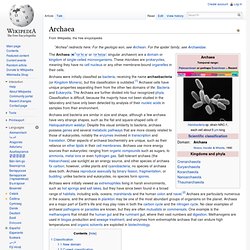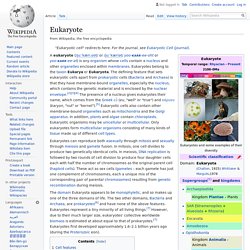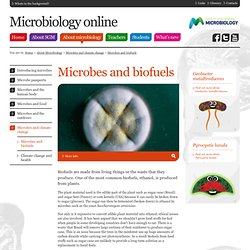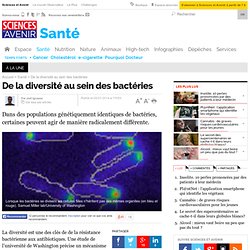

Bacteria. Bacteria ( Most bacteria have not been characterised, and only about half of the bacterial phyla have species that can be grown in the laboratory.[10] The study of bacteria is known as bacteriology, a branch of microbiology.

Etymology Origin and early evolution Morphology Many bacterial species exist simply as single cells, others associate in characteristic patterns: Neisseria form diploids (pairs), Streptococcus form chains, and Staphylococcus group together in "bunch of grapes" clusters. Even more complex morphological changes are sometimes possible. Cellular structure Structure and contents of a typical gram-positive bacterial cell (seen by the fact that only one cell membrane is present). Intracellular structures The bacterial cell is surrounded by a cell membrane (also known as a lipid, cytoplasmic or plasma membrane). Many important biochemical reactions, such as energy generation, use concentration gradients across membranes. Archaea. The Archaea ( Archaea were initially classified as bacteria, receiving the name archaebacteria (or Kingdom Monera), but this classification is outdated.[1] Archaeal cells have unique properties separating them from the other two domains of life: Bacteria and Eukaryota.

The Archaea are further divided into four recognized phyla. Classification is difficult, because the majority have not been studied in the laboratory and have only been detected by analysis of their nucleic acids in samples from their environment. Prokaryote. Cell structure of a bacterium , one of the two domains of prokaryotic life. The division to prokaryotes and eukaryotes reflects two distinct levels of cellular organization rather than biological classification of species.
Prokaryotes include two major classification domains: the bacteria and the archaea . Archaea were recognized as a domain of life in 1990. These organisms were originally thought to live only in inhospitable conditions such as extremes of temperature , pH , and radiation but have since been found in all types of habitats . [ edit ] Relationship to eukaryotes The division to prokaryotes and eukaryotes is usually considered the most important distinction among organisms.
Prokaryotes lack distinct mitochondria and chloroplasts . Eukaryote. Eukaryotes can reproduce both asexually through mitosis and sexually through meiosis and gamete fusion.

In mitosis, one cell divides to produce two genetically identical cells. Biofilm. IUPAC definition Aggregate of microorganisms in which cells that are frequently embedded within a self-produced matrix of extracellular polymeric substance (EPS) adhere to each other and/or to a surface.

Note 1: A biofilm is a fixed system that can be adapted internally to environmental conditions by its inhabitants. L'étonnante stabilité de notre flore bactérienne. Colorations des structures cellulaires. About Microbiology - Microbes and climate change - Microbes and biofuels. Biofuels are made from living things or the waste that they produce.

One of the most common biofuels, ethanol, is produced from plants. The plant material used is the edible part of the plant such as sugar cane (Brazil) and sugar beet (France) or corn kernels (USA) because it can easily be broken down to sugar (glucose). The sugar can then be fermented (broken down) to ethanol by microbes such as the yeast Saccharomyces cerevisiae. Not only is it expensive to convert edible plant material into ethanol; ethical issues are also involved. It has been argued that we shouldn’t grow food stuffs for fuel when people in some developing countries don’t have enough to eat. Scientists are investigating the use of cellulose to produce ethanol. Scientists have turned to their attention to microbes to see if they can find any that are capable of converting the cellulose and even hemicellulose in lignocellulose into ethanol. Another common wood digester is the fungus Trichoderma reesei.
Microbiology posters and booklets. SGM produces a wide range of microbiology teaching resources for all age groups from primary to post-16.

The material is carefully targeted to meet curriculum requirements and fit in with the specifications for science. Single copies of non-chargeable resources are free to anyone involved with teaching microbiology in the UK and Ireland, classroom sets of these resources, along with single copies of chargeable resources, are available if you have School Membership of the Society only. Unfortunately we cannot supply resources free of charge to non-members outside of the UK and Ireland, if you are based in an International School please get in touch to discuss the supply of resources. Featured resource. Microbiologie alimentaire. Le rôle des microbes dans la fabrication des aliments De très nombreux produits alimentaires sont élaborés avec l'aide de microorganismes.

Introduction to geomicrobiology. Microbiologie (Prescott) Bioenergetic processes of Cyanobacteria. De la diversité au sein des bactéries. La diversité est une des clés de de la résistance bactérienne aux antibiotiques.

Une étude de l’université de Washington précise un mécanisme dans les cellules bactériennes qui est une clé de cette diversité. Un nouveau mode de diversification Lorsqu’elle se divise, une bactérie peut donner naissance à deux cellules qui possèdent le même génome mais pour lesquelles le partage des organites cellulaires n'a pas été équitable. Ainsi une bactérie qui possède un flagelle va donner naissance à une cellule munie de cette structure et à une autre qui en est dénuée mais qui pourra en fabriquer un grâce à sa machinerie génétique. Les chercheurs ont constaté que ces deux cellules filles avaient des comportements radicalement différents.
C'est un autre moyen pour les cellules de se diversifier. C-di-GMP.